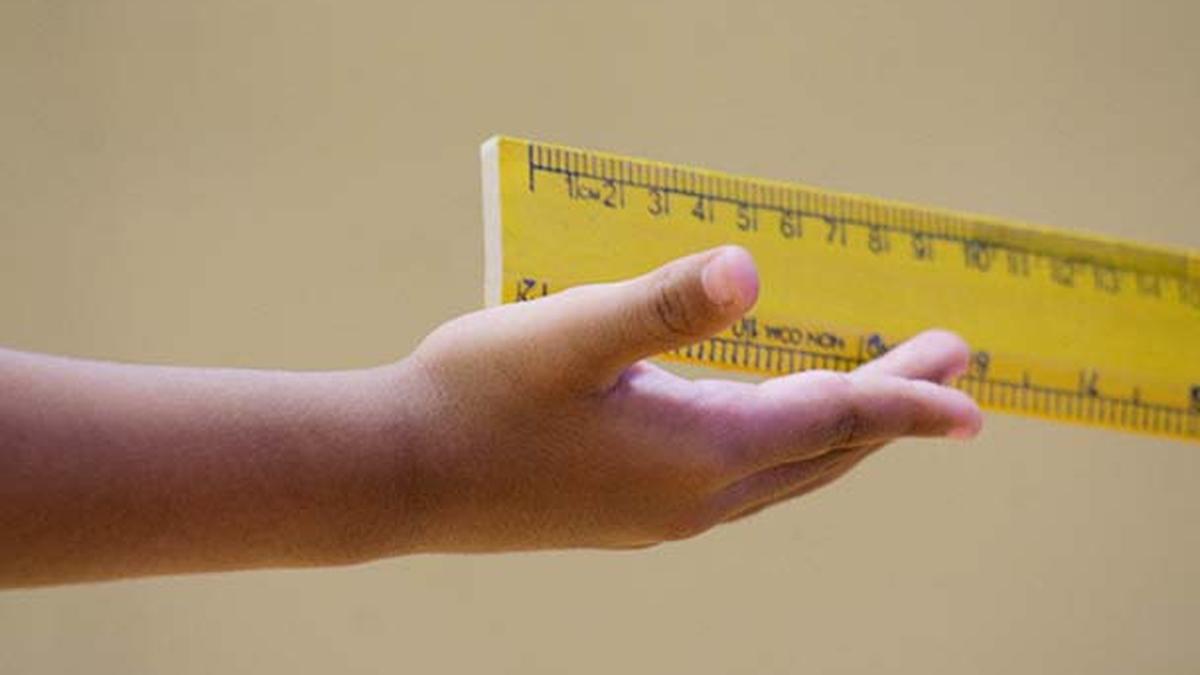
The effects of corporal punishment is also not confined to the child who experiences it but can set off a continuous cycle of inter-generational trauma.
| Photo Credit: K. Ananthan
In more conservative cultures, corporal punishment is more likely to be heralded as a parenting technique honed and perfected through the passage of time, with each generation passing it down as if it were a family heirloom. “This is how we were raised, and we turned out completely fine,” continues to be a classic fallback, words that seem perfectly routine to Indian adults and children alike.
Some independent surveys conducted in India reflect a pervasiveness of corporal punishment; one nationwide study finds that nearly 77.5% of parents resort to hitting their children to discipline them. The persistence of this parenting practice calls for a re-evaluation of the undisputed cultural legitimacy of physical punishment in India.
Corporal punishment has long evaded its classification as abuse because the focus has long been on intent rather than impact. Moreover, the bridge between physical discipline and abuse is often culturally constructed, with some societies more accepting of it than others. But when the paradigm shifts to a focus on impact, the distinction between the two quickly starts to fade. A large body of research, and especially across different country contexts, has established a strong link between corporal punishment and increased behavioural and emotional problems in children — issues that often persist into adulthood as depression and low self-esteem, blurring the line between what is considered discipline and what is, in effect, harm. These effects were further confirmed when researchers observed the brains of affected children: a landmark 2021 study showed that children who were spanked can have unusual brain responses in the same areas affected by more severe types of abuse. At the cost of these detrimental impacts, physical disciplining doesn’t even achieve what it sets out to achieve. While it may achieve short term obedience, there are no persistent positive outcomes observed in the longer term.
Nevertheless, proponents of moderate and “reasonable” corporal punishment may still find comfort in the vague causality of various studies. The empirical link between corporal punishment and child outcomes can be difficult to unpack and communicate, as child outcomes — both short- and long-term — can be complex and induced by various social phenomena. But this misses the larger point: even with sheer majority of studies striving for methodological rigour and establishing a highly likely link between corporal punishment and negative child outcomes, is it still defensible to lean on uncertainty as justification? Moreover, the consistent failure of corporal punishment further reinforces the question: are we truly willing to gamble with children’s well-being for a practice that is, at best, ineffective?
The effects of corporal punishment is also not confined to the child who experiences it but can set off a continuous cycle of inter-generational trauma. Further research shows that adults who were subjected to physical punishment in childhood are more likely to use the same methods when parenting. Crucially, this also the blurs the line between the cultural norms and the transmission of trauma: is corporal punishment truly a widespread and passed-down parenting tradition, or is it trauma masquerading as culture?
Given the impact of corporal punishment, it may be tempting to resort to vilification of the parents who turn to such disciplining methods. But such vilification is not only counter-productive but refuses to address the sheer influence of the social and psychological circumstances — be it culture or trauma — that shape an individual’s parenting habits. Economic hardship adds yet another layer of complexity. Amidst infinite economic and social burdens, a disciplinary method that appears to offer quick results without immediate visible harm can seem like a practical, and even necessary, choice.
Against these challenges, a flat ban on all forms of corporal punishment — especially within households where it often persists despite existing school bans — may seem like the panacea. With evidence pointing towards the efficacy of bans in other developed and developing countries, this is certainly a critical first step, but far from a sufficient one. The rule of law can only go so far in a country where social norms, beliefs, and informal institutions have the final say, especially within the confines of individual households.
Change must occur from within, as much as it needs to be urged externally. Legal reform without a transformation in cultural attitudes and beliefs risks leaving corporal punishment lurking beneath the surface. After all, the inefficacy of coercion in bringing about lasting behavioural change is echoed within the practice of corporal punishment itself. A lasting solution will require a combination of legal reform, public education, and behavioural nudges that work together to shift social norms and equip caregivers with non-violent tools for discipline.
Changing rigid cultural patterns associated with corporal punishment is no doubt going to be a difficult task, requiring a range of psychological, social, and institutional interventions. But we can first start by acknowledging that a problem exists in the first place. In the case of corporal punishment, the lasting harm it inflicts far outweighs — and ultimately transcends — cultural preferences. Perhaps the real question is not where the line lies between corporal punishment and abuse, but whether such a line exists at all.
Published – August 03, 2025 04:38 am IST
